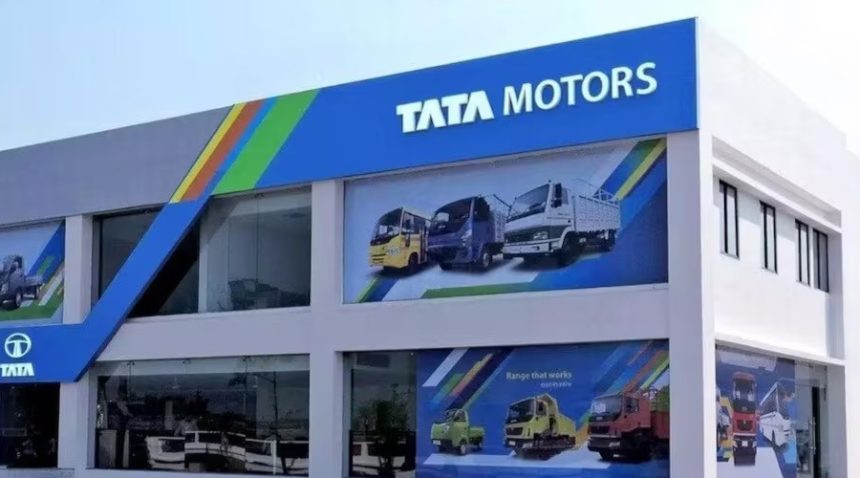The new US-UK deal cuts tariffs—will it be enough to boost Jaguar Land Rover’s profits and lift Tata Motors
Tata Motors, one of India’s largest automobile companies, has faced a bumpy ride in recent weeks. Its stock has dropped almost 8% over just a few trading days. This sudden fall comes after its luxury car brand, Jaguar Land Rover (JLR), shared weak financial guidance for the coming year.
But now, there’s a new development that could change the game: a fresh trade agreement between the United States and the United Kingdom. Many investors are wondering—can this deal help JLR bounce back and improve Tata Motors’ performance?
Let’s take a closer look at what’s happening and what lies ahead.
What’s Going On with Tata Motors Stock
Tata Motors’ stock recently slipped by nearly 8% in four sessions. This happened mostly because JLR, which contributes a large part of Tata Motors’ revenue, warned that its profits would likely be lower in the coming year. In the same announcement, JLR said its free cash flow would be close to zero, and it reduced its expected operating profit margin to between 5% and 7%.
This is a drop from last year’s margin of about 8.5%. When a company earns less profit on every sale, investors tend to get nervous—and that’s exactly what caused the stock to drop.
Why Is JLR Struggling?
US Tariffs on Imported Cars
One of the biggest reasons for the weaker outlook is the new 25% tariff the U.S. has imposed on imported vehicles from the UK. In April, this forced JLR to temporarily stop shipping vehicles from the UK to the U.S.—a key market.
However, a new trade deal between the US and the UK changed things. Under the agreement, tariffs were reduced to 10% for up to 100,000 vehicles per year imported from the UK. This has allowed JLR to resume shipments of models like the Range Rover that are built in the UK.
But not all JLR vehicles are built in the UK. For example, the popular Defender is built in Slovakia, and it still faces the higher 25% tariff. This limits the benefits of the deal.
Falling Demand in China
China is one of JLR’s biggest markets. However, in recent months, luxury car sales in China have slowed down. This is partly because the economy is growing more slowly and consumers are cutting back on big purchases. JLR has already said that this weak demand in China is likely to hurt its overall earnings.
High Costs and Global Pressures
JLR is also dealing with rising costs, including higher prices for raw materials like aluminium and increased warranty expenses. On top of that, the company is investing heavily in developing electric vehicles (EVs). While these investments are important for the future, they reduce profits in the short term.
What Does the New US-UK Trade Deal Offer?
The new agreement between the U.S. and the UK brings several changes, including:
Lower Tariffs: UK-made vehicles will now face only a 10% tariff instead of 25%, but only for the first 100,000 cars shipped to the U.S. each year.
Applies Only to UK-made Cars: Vehicles built in the European Union (like in Slovakia) are not covered. So, models like the Defender still face higher tariffs.
Limited Impact for JLR: Since not all JLR vehicles are made in the UK, the overall benefit is limited. Only part of the company’s lineup will see cost advantages in the U.S. market.
Still, the deal is a step forward. It allows JLR to once again sell popular UK-built models in the U.S. without heavy extra costs.
Can This Help JLR and Tata Motors?
Short-Term Impact
The deal gives some relief, but it won’t fix all of JLR’s problems right away. The lower tariffs apply only to a portion of vehicles, and U.S. demand may take time to recover fully. Also, other challenges like high costs and slow Chinese demand are not solved by this trade agreement.
Medium-to-Long-Term Outlook
JLR is planning to cut costs by around £1.4 billion by 2027 through restructuring. This includes streamlining operations, reducing spending, and improving manufacturing efficiency.
The company is also preparing to launch several electric vehicles. These include a battery-electric Range Rover, new Jaguar electric cars, and a Freelander EV in China under a joint venture. If these new models succeed, they can bring in higher profits and improve brand image.
JLR has set a target to bring profit margins back to 10% by 2027–2028 and as high as 15% in the long run. These are ambitious goals, but they show that the company is focused on long-term growth.
What Are Analysts and Brokerages Saying?
Several analysts have updated their forecasts for Tata Motors and JLR. Most have lowered their earnings estimates and target prices. Some brokerages have kept their ratings at “Buy” or “Neutral,” but others have downgraded the stock to “Reduce” or “Underperform.”
The common view is that the new trade deal is helpful but not enough to offset all of JLR’s current challenges. Until demand improves in key markets like China and the U.S., and until the company can reduce costs, performance may stay under pressure.
What Else Is Tata Motors Doing?
While JLR struggles, Tata Motors’ domestic business in India is showing better signs.
Electric Vehicles (EVs): Tata Motors is the leader in India’s passenger EV market. Its models, like the Nexon EV and Tiago EV, are popular, and more models are in the pipeline.
Commercial Vehicles: Demand for trucks and buses is steady, especially from the construction and logistics sectors.
Business Restructuring: Tata Motors recently announced a plan to split its business into two separate units—one for EVs and one for traditional vehicles (ICE). This move is expected to attract new investors and improve management focus.
What to Watch Going Forward
|
Key Factor |
Why It Matters |
|
Tariff Rules |
More clarity or expansion of the deal could improve exports. |
|
China Demand |
A rebound in Chinese car sales would lift revenue. |
|
EV Launches |
New electric models could increase market share and profits. |
|
Cost-Cutting |
Hitting savings targets would improve margins. |
|
New Deals |
Any broader UK-EU-U.S. trade deals could change the landscape. |
Final Thoughts
The U.S.–UK trade deal offers some breathing room to Jaguar Land Rover. It allows a key part of JLR’s lineup to avoid high tariffs and helps resume sales in one of its most important markets. But the benefits are limited in size and scope. Many models are still subject to full tariffs, and challenges like falling demand in China, rising costs, and tight margins remain.
Tata Motors must continue working on cost control, expanding its electric vehicle offerings, and navigating a tough global economy. The road ahead may be rough in the short term, but if the company delivers on its plans and global conditions improve, stronger days may be ahead.
For now, the trade deal is a helpful tool, but not a complete solution. JLR’s recovery will depend on many moving parts coming together over time





